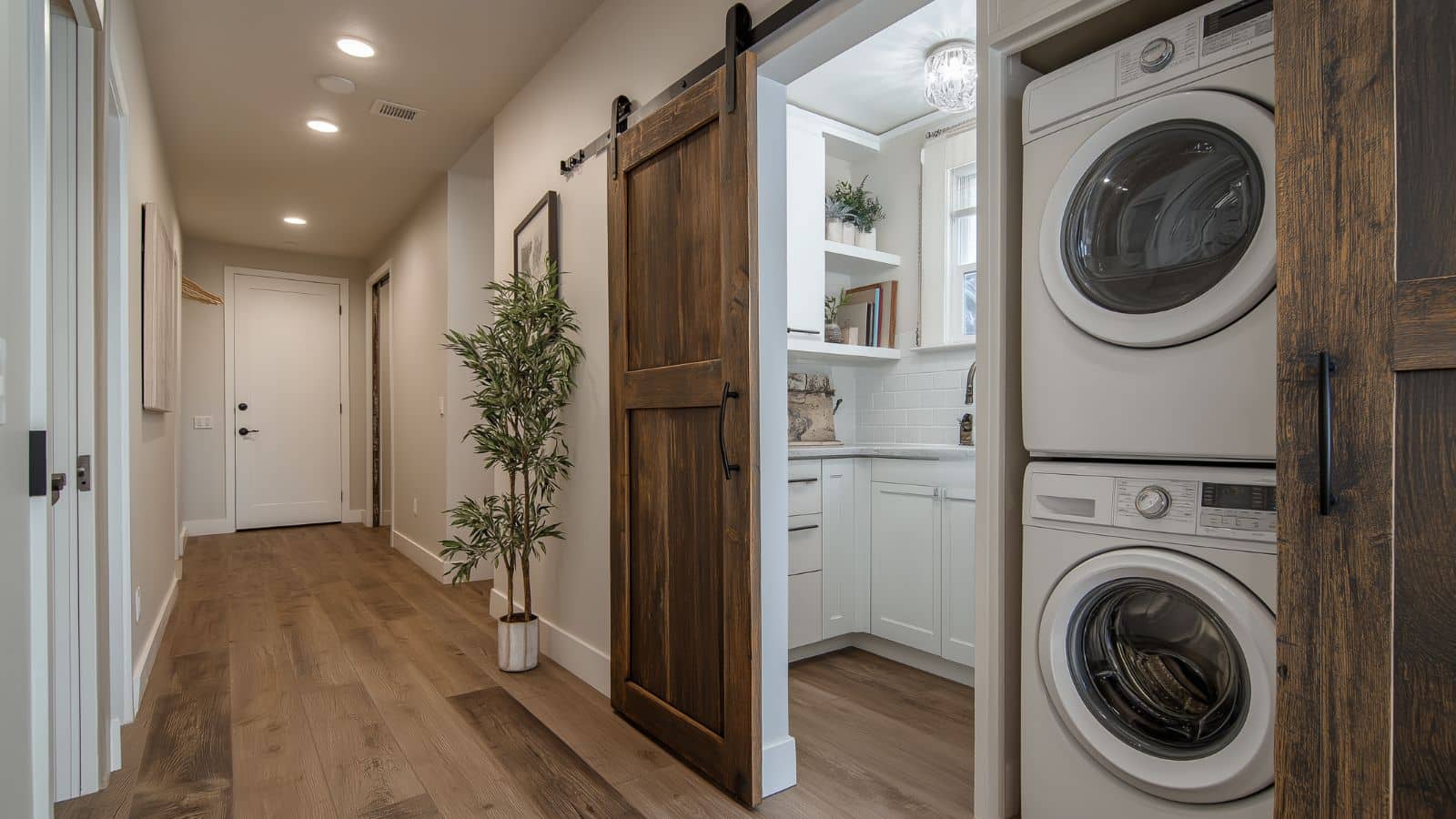Compact Hallway Laundry Closet with Stackable Units: Space-Saving Design Tips and Styling Ideas
Table of Contents
Small-space living is no longer just a trend—it’s a necessity for many modern homeowners. With real estate shrinking and multifunctional design rising in popularity, it’s no surprise that the hallway laundry closet has emerged as a favorite space-saving solution. And when paired with stackable washer and dryer units, this setup offers a perfect blend of function, efficiency, and style.
According to a National Kitchen & Bath Association survey, over 40% of homeowners are integrating laundry appliances into unconventional spaces—including closets, mudrooms, and even hallways. The compact hallway laundry closet is now a practical solution for small homes, urban apartments, and minimalist designs.
But compact doesn’t have to mean cramped. With thoughtful planning, smart storage solutions, and aesthetic design touches, a hallway laundry closet can be both stylish and highly functional. This guide will explore how to create an efficient laundry space using stackable washer and dryer units—without sacrificing beauty or comfort. From layout planning to cabinetry, lighting, and organizational tips, you’ll learn how to transform a tight corridor into a seamless laundry zone that serves your home beautifully.
Planning the Perfect Hallway Laundry Layout
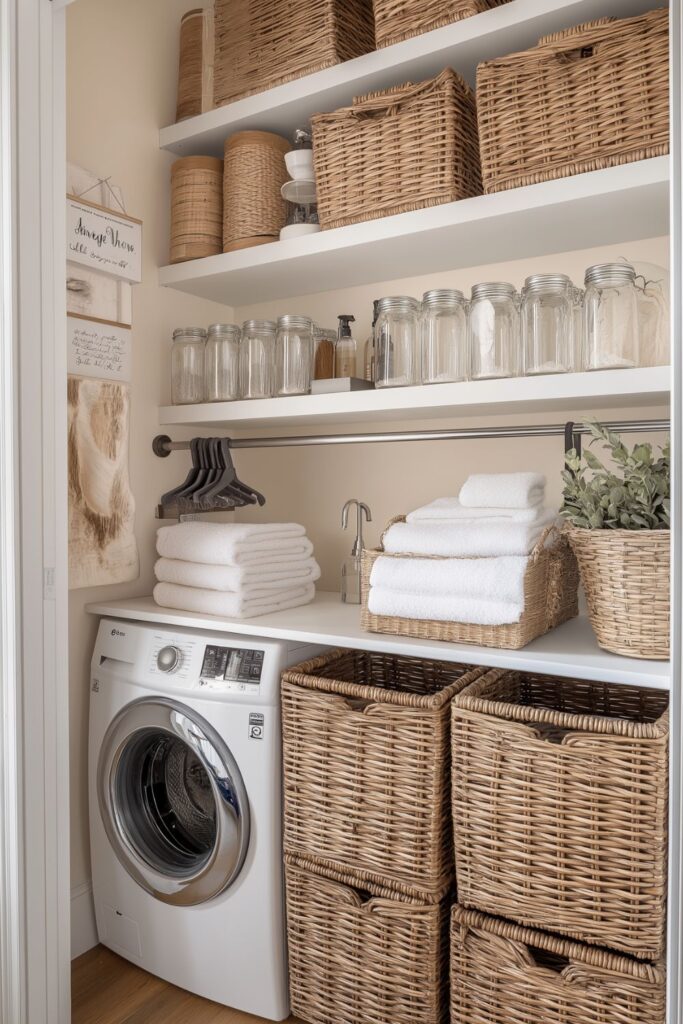
When working with a hallway laundry closet, efficient layout planning is key. You have limited space, and every inch counts—especially when fitting in appliances, doors, shelves, and storage. The good news? Stackable units open up vertical possibilities that side-by-side machines simply can’t offer.
Start with Accurate Measurements
Before selecting any unit or cabinet, take precise measurements of your hallway’s depth, width, and ceiling height. Consider door clearance, plumbing locations, and electrical hookups as well. Don’t forget to factor in space for ventilation and noise control.
Decide on Door Style
In a hallway, swinging doors may eat up too much space. Consider sliding barn doors, bifold panels, or custom cabinet fronts to conceal the machines when not in use. Pocket doors are another sleek option for tight corridors.
Allow for Working Space
Even if you’re dealing with a narrow footprint, make sure there’s enough room to open the washer and dryer doors, load clothes, and move freely while doing laundry. Think of it as a compact workstation—every movement should be supported by the space.
Hallway Laundry Layout Considerations:
| Layout Element | Ideal Feature | Notes |
|---|---|---|
| Appliance Type | Stackable washer & dryer | Saves floor space |
| Door Style | Sliding or bifold | Prevents hallway congestion |
| Cabinet Depth | 28–30 inches | Enough to house machines and doors |
| Overhead Space | Min. 6 feet 5 inches | Allows for stacked units and ventilation |
Planning the layout upfront avoids frustration later—and ensures the space is as efficient as it is elegant.
Choosing the Right Stackable Washer Dryer for Your Space
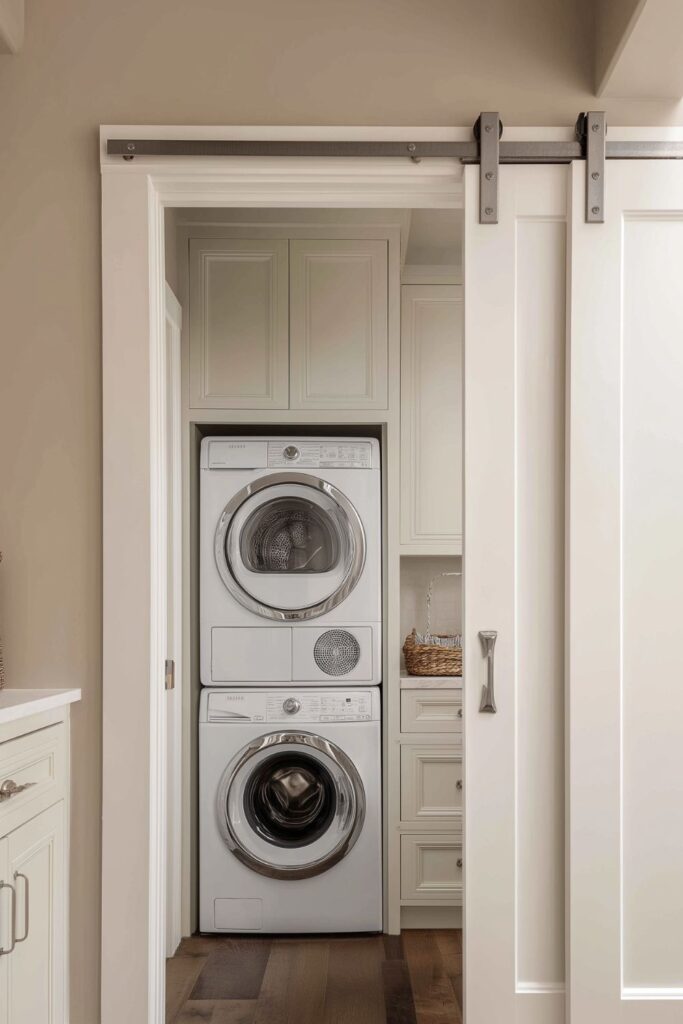
All stackable units are not created equal. When your laundry setup is limited to a hallway closet, choosing the right appliance becomes even more important. Fortunately, today’s models offer excellent features in surprisingly compact packages.
Prioritize Size and Efficiency
Look for units labeled “compact” or “apartment size,” typically measuring around 24 inches wide. These models are perfect for tight spaces while still offering decent load capacity.
Consider Venting Options
Vented dryers generally perform better, but if external venting isn’t possible in your hallway, opt for a high-quality ventless or heat-pump dryer. These units are energy-efficient and ideal for interior installs.
Focus on Quiet Operation
Hallway laundry areas are often close to bedrooms or main living spaces. Choose machines with low-decibel ratings and vibration-reduction technology to keep noise to a minimum.
Comparison of Compact Stackable Units:
| Feature | Compact Units | Standard Units |
|---|---|---|
| Width | 24 inches | 27+ inches |
| Load Capacity | ~2.5–3.5 cu. ft. | 4.5+ cu. ft. |
| Venting | Optional ventless | Usually vented |
| Ideal For | Apartments, narrow closets | Large homes or basements |
Choosing the right appliances will make your small laundry setup work harder—and quieter—for years to come.
Custom Cabinetry for a Seamless Look
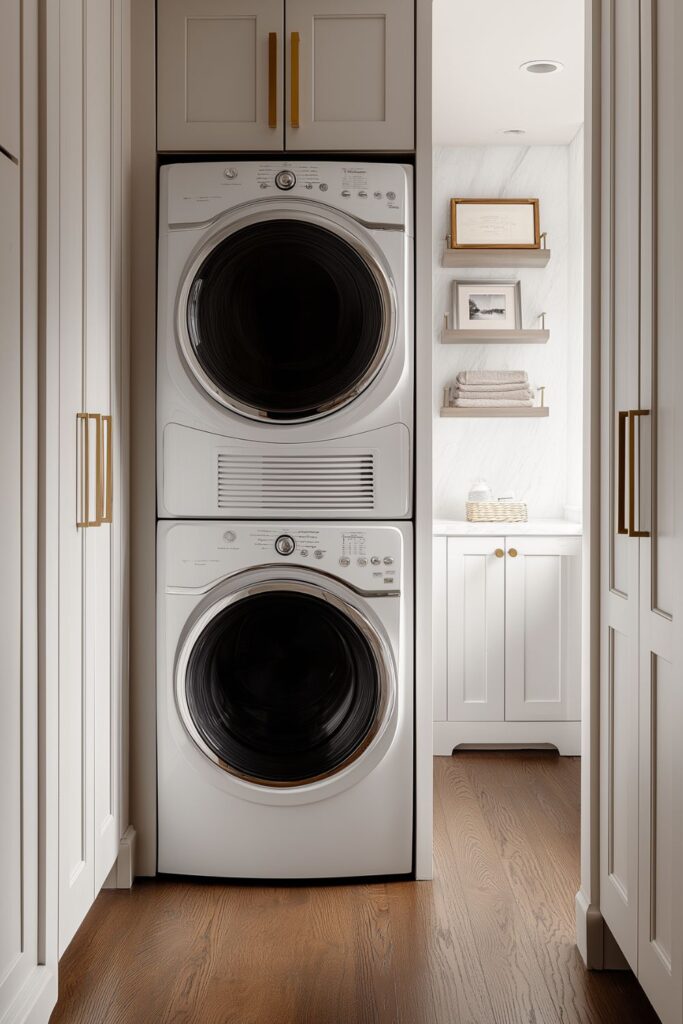
Incorporating cabinetry around your washer and dryer units is one of the most effective ways to turn a functional nook into a streamlined design feature. Custom cabinets keep the laundry area hidden from view while providing much-needed storage.
Conceal and Contain
Full-height cabinet doors or closet-style enclosures allow the washer and dryer to “disappear” into the hallway when not in use. Choose paneling that blends into surrounding walls for a seamless visual flow.
Add Overhead Storage
Cabinets above your stacked units are great for storing detergents, fabric softener, dryer sheets, and small laundry tools. Use matching doors or open shelves depending on your design aesthetic.
Include a Utility Niche or Pull-Out Drawer
If space allows, add a slim pull-out drawer or narrow shelving unit beside the machines for a hamper, basket storage, or extra cleaning supplies.
Laundry Closet Cabinetry Checklist:
| Feature | Function | Style Tip |
|---|---|---|
| Full-height enclosure | Conceals machines | Match trim color to wall paint |
| Overhead cabinet | Storage | Use soft-close doors |
| Side drawer/pull-out | Hidden tools + hamper | Add discreet handles |
| Interior lighting | Visibility in cabinet | Install LED strips for ambiance |
Well-designed cabinetry transforms a utilitarian hallway into a polished and purposeful space.
Optimize Storage Without Sacrificing Style
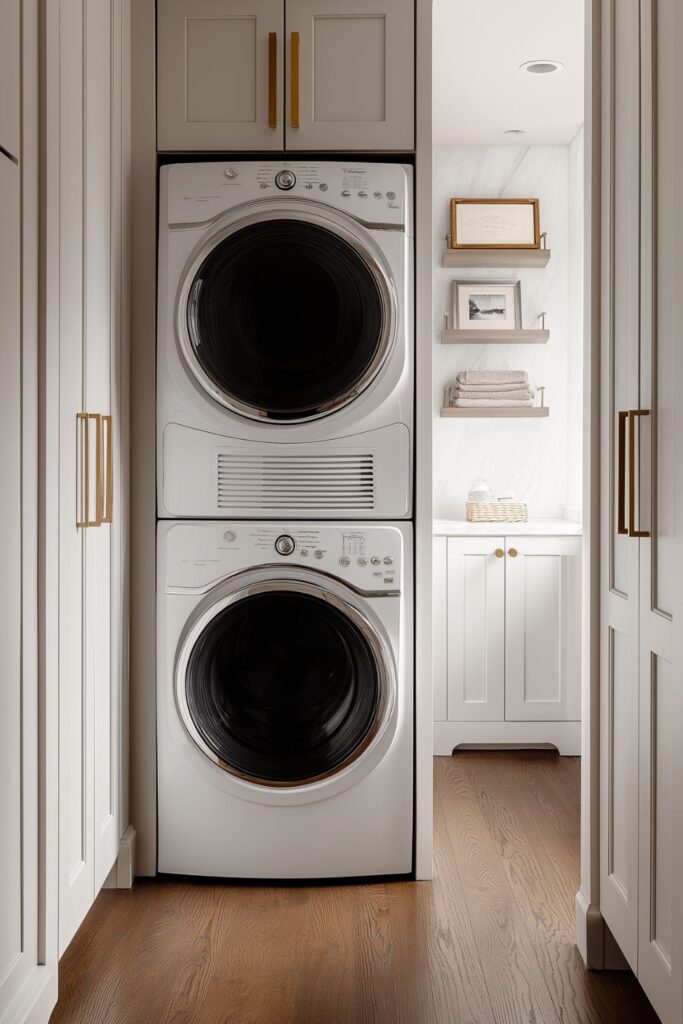
Storage is a key element in any laundry area, especially when working with compact spaces. The challenge lies in organizing smartly while still keeping the space visually appealing.
Use Vertical Wall Space
Install floating shelves above the cabinets or beside the machines. Style them with glass jars, labeled containers, and a decorative plant or two to keep the aesthetic clean but personal.
Choose Functional Baskets and Bins
Use coordinated bins for linens, laundry pods, or stain removers. Woven baskets soften the look, while wire bins offer an industrial edge. Be sure to label for clarity and ease of use.
Add a Drying Rod or Fold-Down Rack
Install a retractable drying rod or slim wall-mounted drying rack for delicates. This provides added functionality without needing extra floor space.
Smart Storage Ideas for Hallway Laundry:
| Item | Placement | Function |
|---|---|---|
| Labeled glass jars | On open shelves | Hold pods, clips, detergent |
| Wicker or wire bins | Inside cabinets | Organize linens, supplies |
| Hanging rod | Under shelf | Drying delicates |
| Slim drawer unit | Next to machine | Hidden utility tools |
A well-styled storage solution ensures your laundry area feels less like a closet and more like part of your home’s design.
Lighting and Ventilation Considerations
A hallway laundry closet doesn’t usually come with the luxury of natural light or airflow, so planning for proper lighting and ventilation is essential to both function and comfort.
Install Task Lighting
Use LED strip lights under cabinets or ceiling-mounted fixtures for even illumination. Motion-activated lights are ideal for enclosed spaces, adding convenience and energy efficiency.
Incorporate Ventilation Solutions
Laundry machines generate heat and moisture, and when placed in an enclosed closet, that can lead to problems. Install a vent fan if possible, or at the very least, louvered doors or ventilation grilles to allow airflow.
Control Humidity
For enclosed hallway units, especially those with ventless dryers, consider a compact dehumidifier. It keeps the air dry and protects nearby walls and cabinetry from moisture buildup.
Lighting & Ventilation Planning Table:
| Element | Purpose | Best Solution |
|---|---|---|
| Ceiling lighting | General illumination | LED flush-mount or puck lights |
| Cabinet lighting | Focused task light | LED strips or motion lights |
| Ventilation | Moisture control | Exhaust fan or louvered doors |
| Humidity control | Long-term air quality | Small dehumidifier or moisture-absorbing packs |
These elements keep your laundry closet clean, comfortable, and functional long after installation.
Styling Tips to Make It Feel Like Home
Just because your laundry area is small doesn’t mean it can’t be beautiful. A few thoughtful styling choices can turn this high-function zone into a space you actually enjoy using.
Choose a Coordinated Color Palette
Keep tones neutral and consistent with surrounding spaces—think soft whites, warm woods, muted grays, or pale sage. A cohesive color palette helps the laundry zone blend rather than stand out.
Add a Touch of Decor
Small framed art, a decorative soap bottle, a vase of eucalyptus, or a handwoven basket can elevate the space while keeping it uncluttered. Avoid overly delicate or unnecessary pieces.
Use Beautiful Everyday Items
Transfer detergent into amber jars or ceramic canisters. Use cloth bins instead of plastic. These upgrades elevate utility into design.
Small-Space Styling Elements Table:
| Decor Piece | Purpose | Aesthetic Benefit |
|---|---|---|
| Framed print | Visual interest | Adds character without bulk |
| Woven basket | Holds linens/supplies | Warm texture |
| Ceramic jar | Stores pods or soap | Simple elegance |
| Small plant | Adds life | Natural freshness in a tight space |
When form meets function, even a hallway laundry closet becomes a space that feels intentionally designed.
Conclusion
A compact hallway laundry closet with stackable units proves that small-space living can still be stylish, efficient, and highly functional. With the right planning—from layout and appliances to cabinetry, storage, and styling—you can transform even the narrowest nook into a hardworking and beautiful part of your home.
Whether you’re outfitting a city apartment or upgrading a guest wing, a hallway laundry area doesn’t have to be an afterthought. With intentional design, it becomes a seamless extension of your home’s aesthetic—one that makes everyday chores a little more enjoyable.

